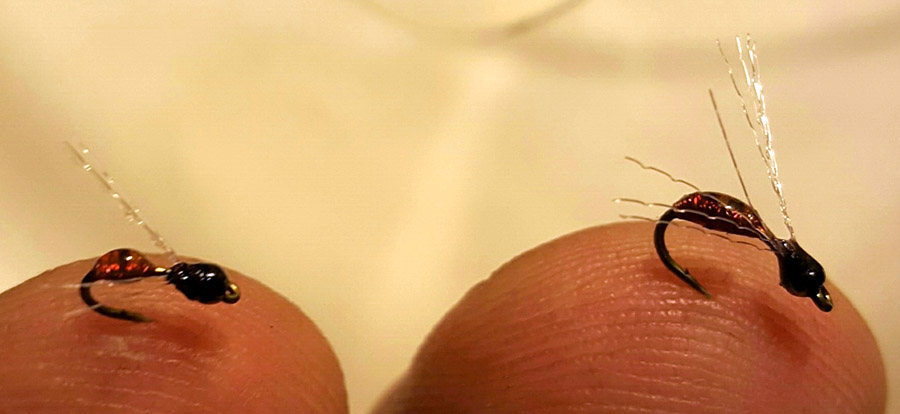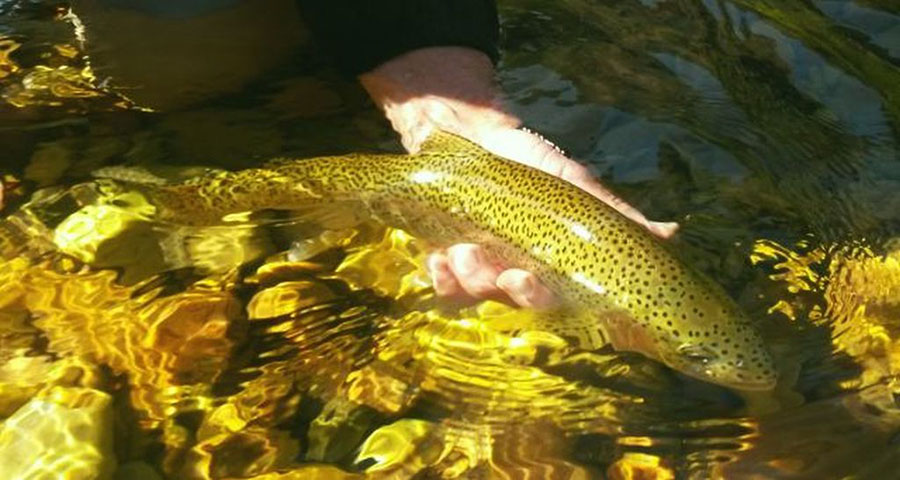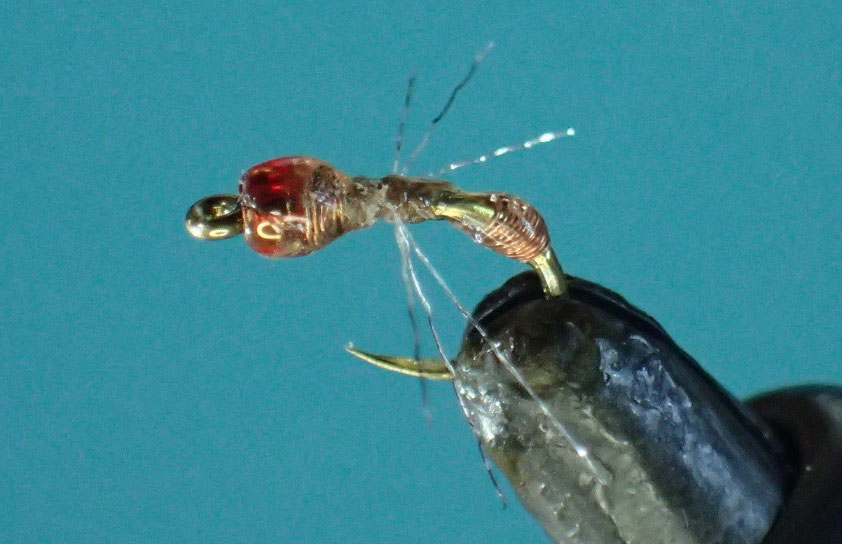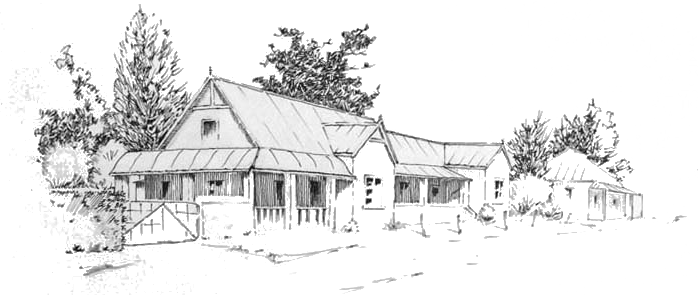- There is little doubt about the importance of ants in the diet of trout, but I suspect that most fly fishers, myself included, have tended to focus more on floating than sunken ant imitations. I also suspect that we haven't given nearly enough attention to fishing ants as micro-patterns – floating or sunken. Ed Herbst and Marcel Terblanche have collaborated for some months now on this very topic and their more than promising findings and results confirm my introductory sentiments. I did include these points in my Newsletter of May 2016, but feel they are so important they warrant an independent posting on my website.
Marcel Terblanche, Western Cape fly fishing guide and professional fly tyer, writes:
I love tying terrestrials and lately my focus has been on ant patterns. Nothing beats taking a trout on a micro ant. After recent success with a #22 Sunken Sugar Ant on the Witels’ wild browns - that would not take any other fly pattern at the time. So I decided to work on a variety of ant designs.
The Spotted Sugar Ant, Camponotus maculatus, and the Fire Ant, Solenopsis punctaticeps, are both widely distributed and prolific throughout South Africa.
Recently I found a nest of Fire Ants in my garden and observed a number of winged ants (alates) embarking on their annual autumn nuptial flight. I noticed that the young nest-bound workers of this species are really small and golden in colour, while the larger foraging workers and the alates were glossy black.
Click in images to enlarge them

A Fire Ant
I went back to my vice and tied a sunken imitation of the black worker ants with the same features as the Sunken Sugar Ant, but I omitted the organza wings.

Earlier Sugar Ant imitations
Instead I added some Ice Wing Fibre for legs. The prototype was tied on a #24 hook with a 1mm glass bead at the head.

My back to front Sunken Fire Ant with Ice Fibre legs
As a professional fly tyer, I field test new designs as they come off the vice, so I headed to a local stream that afternoon and found a good trout feeding on the surface. I tied a #18 Gary Borger Poly Caddis to my tippet and added a New Zealand-rigged Fire Ant to it with a 20 inch section of 7X. The trout was clearly looking to the surface, rising steadily every three to four seconds. I made a presentation and within two seconds the caddis pattern was pulled down. After a delicate battle I landed a spectacular trout of 17 inches.

The 17 inch rainbow deceived by a Sunken Fire Ant.
I am excited about the success of the Sunken Ant patterns compared to conventional nymphing techniques. Trout are hardwired from fingerlings to eat tiny insects and ants feature high on their menu. I have now found it possible to tie a realistic looking Sunken Ant on hooks smaller than #22 by tying the ant back to front using the bead at the hook's eye as the abdomen - thus keeping the hook gape open.
My yearning to take a trout on the surface with a micro ant dry fly did not cease and I was back at the vice with small hooks, foam and Enrico Puglisi Fibres for the wings.
My first attempt at a floating ant pattern looked more like a house fly because my foam was cut too wide and did not match an ant’s profile. I added a dubbed abdomen of Ice Wing and a bundle of Enrico Puglisi Fibre for wings. It looked so much like a real house fly that when I was taking photos, a house fly displayed an inordinate affection for my new creation.

The house fly and 'The Fly'
The trout also loved 'The Fly' and this past weekend I took a beautiful 18-inch rainbow on the Molenaars stream with it. There were numbers of Baetis spinners on the water which the trout was rising to, but it took “The Fly” on the first drift.

The 18 inch rainbow caught on 'The Fly'
Micro patterns and large trout have made the closing weeks of the season on the streams near Cape Town memorable for me. Now it’s time to refine the floating ant with help of my newly-acquired JVice.
It proved difficult to see in the drift so I will experiment with a reflective and brightly-coloured sighter threaded through the shellback using Jay Smit’s ingenious Bodkin Leg Threader
Ed Herbst writes:
Although I am no longer able to fish, I fish by proxy through friends and my friend Marcel Terblanche, as described in this article, has caught two rainbows of close to 18” – one on the copper wire ant which we are collaborating on. Assisting the development of the Sunken Ant has been the advent of short shank, heavy wire hooks such as the TMC 2499 Spear Point, the Hanak 500 BL and the intriguing Allen N304 scud hook which I acquired through Bill and Kathi Morrison at The Bearlodge Angler.( www.bearladgeangler.com )All are short shank hooks which enable one to use the option employed by John Goddard on his smut pattern, small body on a big hook.

Three short-shank hooks, the Hanak (left) TMC 2499 (middle) and Allen N304 (right). The Hanak is available down to #16, the TMC down to #18 and the heavy wire Allen hook down to #24
Beetles are seasonal so when my sunken beetle fished like a nymph with a strike indicator seemed less productive I switched to a copper wire ant because ants were ever-present. I was inspired by Vincent Marinaro’s observation that while black ants are opaque, red ants glowed as though “lighted by some inner fire”. (A Modern Dry Fly Code P86).

Prototype of my Copper Wire Ant
Copper wire, being malleable, allowed me to build an oval shape of the right colour and then to turn it into a flattened oval with fine-nose pliers. Traditionally the bigger oval of copper wire was at the bend but, recently, I realised that if I turned the traditional shape of the ant around and placed - on the smaller hooks - the smaller blob representing the head at the bend, I could incorporate a 1.5 mm bead – glass, brass or tungsten –along with the bulk of the eye to represent the abdomen – a back-to-front ant. This would not reduce the hook gape. Although winged ants (alates) only appear briefly during the autumn nuptial flights, I tried to retain the narrow waist characteristic of ants by using a spent-wing of white organza stippled with a permanent marker. This has worked on the Witels and the Smalblaar streams and Marcel is also using black Hareline UV Ice Wing for legs on some of his sunken ants.
A further breakthrough was reading about Sally Hansen’s 'Mega Shine', an internationally acclaimed nail polish, in Steve Thornton’s book, 'Listen to the River'. This is better than the 'Hard as Nails' which most people use, because it dries in a minute and contains minute flecks of reflecting material. This protects the first coat of fluorescing UV light-cured resin such as Deer Creek or Loon. In South Africa it is available, inter alia, in Dis-Chem pharmacies and Clicks stores.

My current back-to-front Copper Wire Ant tied on a #18 TMC 2499 hook and using a glass bead at the hook eye to represent the abdomen
My grateful thanks to Frontier Fly Fishing in Johannesburg for sending me some 1.5 mm brass beads in copper at short notice
A reminder that Peter Sligsby book on the ants of southern Africa is soon to be published.

The cover of Peter Slingsby’s new book

One of Peter Slingsby’s paintings of the Spotted Sugar Ant. Copyright Peter Slingsby and used with permission.
To end with a quote:
“The ant in its many forms has long been a great favourite with anglers. Edward Ringwood Hewitt once said ‘Ants are a trout’s greatest love.’ In my own experience, the Black Flying Ant has proven one of the greatest fish-takers throughout all my fishing life.”
Joe Brooks, Trout Fishing, 1972.
And my thanks to Ed Herbst and Marcel Terblanche for their revelations on ant patterns.



